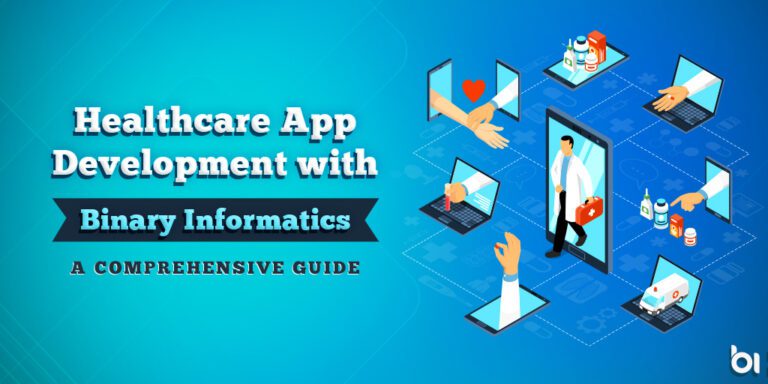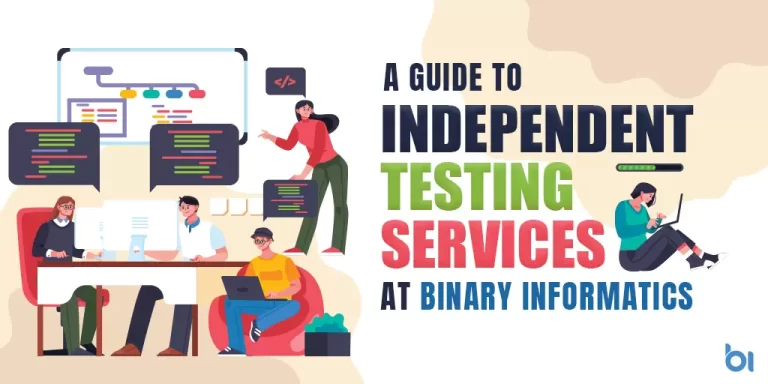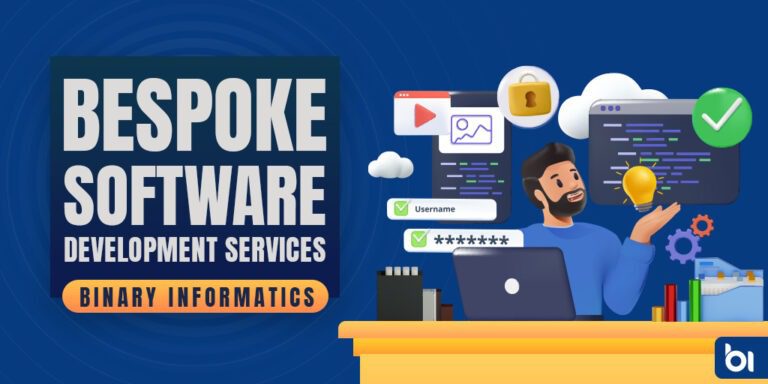Healthcare App Development is continuously evolving, and technology has played a crucial role in this transformation. The use of healthcare apps has significantly impacted the delivery and accessibility of healthcare services to patients.
Mobile device technology enables patients to easily access medical information, schedule appointments, and receive virtual consultations without leaving home. Healthcare app development also brings efficiency to medical professionals who can easily access patient records and streamline communication with colleagues.
Why Binary Informatics is a Trusted Partner for Healthcare App Development

Binary Informatics is a leading technology partner for businesses across various industries, including healthcare. Our company possesses extensive expertise in developing innovative solutions that streamline processes and enhance user experiences.
With an in-house team of highly skilled developers, Binary Informatics utilizes cutting-edge technology to create customized healthcare apps that meet unique business needs. As a trusted partner for healthcare app development, Binary Informatics takes stringent measures to ensure its products are compliant with regulatory standards such as HIPAA compliance regulations.
Our company adheres to stringent data security protocols that protect patient information from unwarranted access or cyber-attack. Binary Informatics also provides ongoing support to its clients after launching their apps on the market.
Maintenance services offered by this company include bug fixes and upgrades that ensure an app continues to perform optimally over time. Partnering with Binary Informatics means having a reliable technology partner that understands your unique business needs while offering top-of-the-line solutions that meet regulatory requirements.
Understanding the Healthcare Industry

Healthcare is one of the world’s most critical and complex industries, creating unique challenges for app developers wishing to create healthcare apps. From navigating strict regulations and complex data privacy laws to working within an industry-wide culture of caution, there are many factors that developers must consider when creating healthcare apps. However, these challenges do not obscure the vast opportunities that lie within this sector for innovation.
Overview of the Healthcare Industry
Healthcare covers an expansive array of services and providers, from hospitals and clinics to private practices and community health centers. In recent years, the focus has shifted from treating acute illnesses to promoting overall wellness through preventive care measures.
Healthcare’s main purpose is to enhance people’s quality of life, so delivering care that addresses both physical and mental health issues becomes ever more essential. Innovative care delivery models must take account of each patient’s specific requirements in order to provide optimal care services.
Discussion on How Technology Can Improve Healthcare Delivery
Technology has revolutionized healthcare over the past several decades. From electronic health records (EHRs) to telemedicine platforms, advances have made accessing high-quality care easier than ever for patients.
In addition, mobile applications have emerged as an important tool for helping patients manage their own health more effectively. They can be used for everything from tracking medication schedules and monitoring symptoms to providing access to online support communities.
As we consider the future of healthcare delivery, technology will undoubtedly play a vital role in improving patient outcomes while simultaneously controlling costs. Whether through AI-powered diagnostic tools or VR-based therapies for chronic pain management, there are countless opportunities for developers looking to make a difference in this space.
Planning Your Healthcare App Development

Identifying your target audience and their needs
The first step in planning your healthcare app development is identifying your target audience. Who do you wish to reach with your app and what are their specific needs? Healthcare industries cater to a range of audiences that may include patients, physicians, nurses, and other healthcare professionals. To best identify your target audience’s needs and requirements it is imperative that research be conducted and feedback collected from potential users.
Focus groups, surveys, or interviews with stakeholders from the healthcare industry are effective methods for gathering this information. Gaining a comprehensive knowledge of your target audience’s needs and pain points enables you to craft an app tailored specifically to address them effectively.
In the healthcare industry, this may be patients, physicians, nurses, or other medical professionals. To identify your target audience’s needs, it’s important to conduct research and gather feedback from potential users.
This can be done through focus groups, surveys, or interviews with stakeholders in the healthcare industry. By gaining a thorough understanding of your audience’s needs and pain points, you can ensure that your app is tailored to meet those needs effectively.
Defining your app’s features and functionality
Once you have identified your target audience and their specific needs, the next step is defining the features and functionality of your healthcare app. Consider what features are necessary to meet the unique requirements of the healthcare industry while providing value to users.
Should it include features such as telemedicine consultations or appointment scheduling? Defining these features early on will help ensure that they are properly incorporated into the design and development process.
Creating a project plan and timeline
With a clear understanding of your target audience’s needs and the features required for successful healthcare app development in place; it’s time to create a project plan that outlines each stage of development clearly. The timeline specifies all deadlines by which tasks should be completed before moving on to subsequent stages. A project plan should also include key milestones that indicate when certain stages or components of development will be completed.
This provides developers with clear checkpoints throughout the process where they can evaluate progress toward project goals while also ensuring that everyone involved has transparent access to how long each phase will take. Additionally, setting timelines will help you manage resources effectively and ensure that your project remains on track for completion.
Designing Your Healthcare App

User Interface Design Considerations for Healthcare Apps
User interface design is an essential component of healthcare app development. A well-designed user interface can significantly impact the user experience, patient engagement, and satisfaction levels.
When designing a healthcare app’s UI, it’s crucial to consider the end-users needs and preferences. For example, elderly patients may prefer larger fonts and simplified designs that are easy to navigate.
Meanwhile, younger generations may prefer more modern designs with vibrant colors and interactive elements. Moreover, it’s important to incorporate visual aids such as images or videos that help users understand complex medical terminology or procedures.
Best Practices for Designing User-Friendly, Intuitive Interfaces
Designing user-friendly and intuitive interfaces is vital to ensure users can easily navigate your healthcare app without confusion. Here are some best practices for designing a user-friendly UI:
Use a clear hierarchy of information: When presenting medical information, establish an order of importance within your app’s layout.
Make use of white space: Too much information cluttered together can be overwhelming; therefore employing white space between groups of related information helps users identify patterns effortlessly.
Use consistent layouts: Consistency in layout carries over from screen to screen; this creates navigational ease throughout the application.
Incorporate familiar design patterns: By using design patterns that users recognize from other apps on their devices makes it easy for them to familiarize themselves with your application.
Incorporating Necessary Features such as HIPAA Compliance, Data Security, etc.
Healthcare apps handle sensitive patient data; hence incorporating necessary features such as HIPAA compliance and data security is critical during development. HIPAA compliance ensures that patient data is secure by requiring strict privacy regulations enforced by law.
Developers must implement technical safeguards like encryption during the transmission or storage of personal health information( PHI). The app should also have a compliant Privacy Policy, which is reviewed and updated frequently.
Incorporating data security measures such as firewalls, VPNs and two-factor authentication increases the secure handling of patient data. Furthermore, using data anonymization techniques gives users peace of mind that their health records remain confidential.
Designing user-friendly healthcare apps while considering the specific needs of patients is vital to ensure ease of use and satisfaction for end-users. Also, incorporating necessary features such as HIPAA compliance and data security is crucial during development to maintain patient privacy and build a trustworthy brand reputation.
Developing Your Healthcare App
Choosing the Right Technology Stack for Your App’s Needs
| Front-end technologies | HTML, CSS, JavaScript, Angular, React, and Vue.js |
| Back-end technologies | Java, Python, Ruby, and Node.js |
| Operating System | iOS, Android, Cross-platform |
| Frameworks | Spring, Django, Flask, and Ruby on Rails |
| Database | MySQL, Oracle, PostgreSQL, Memcached, NoSQL |
| Big Data Tools | Apache Spark |
| Cloud Storage | Amazon Web Services (AWS), Microsoft Azure, Google Cloud Platform (GCP), DigitalOcean |
| Back-end Servers | Apache, NGINX |
| iOS | Swift |
| Android | Java |
| Trending Technologies | Cloud computing, 5G, AI, NLP, IoMT (Internet of Medical Things), AR/VR |
Finding the appropriate technology stack for your healthcare app is key to its smooth running. A technology stack comprises all the components required for developing apps, including programming languages, frameworks, libraries, and databases.
At Binary Informatics, we have a team of expert developers who can help you choose the right technology stack based on your specific business requirements. We consider factors such as scalability, security, performance, and cost-effectiveness while recommending a suitable tech stack.
Similarly, if you want to ensure data privacy and security compliance with HIPAA regulations in your app development process then we will suggest using technologies such as .NET or JAVA.
Building out Core Features and Functionality
The features of a healthcare app must be carefully planned keeping in mind end-users’ needs. While building out core features for your healthcare app’s functionality it’s important to keep end-users at the center of all decisions. At Binary Informatics our developers follow an Agile development methodology where they work closely with clients to understand their vision and requirements.
We believe that a successful healthcare app should provide users with easy access to their medical information along with other important features like appointment scheduling & reminders feature reliability and an advanced search capability that lets users find relevant doctors quickly. This helps create an engaging user experience and generates more adoption of the application.
Integrating with Third-Party Tools and Services
Integrating third-party tools and services is another critical step in developing a successful healthcare application. Third-party tools offer additional functionalities that can enhance user experience while saving time on developing custom solutions from scratch.
At Binary Informatics our team works with several third-party tools and services to build healthcare applications. We have experience integrating with electronic health record systems, patient portals, and telemedicine platforms.
We make sure that all the integrations are seamless and secure while ensuring compliance with regulatory standards. Integrating third-party tools can provide greater value for your healthcare app’s end-users which can lead to a better patient experience.
Testing Your Healthcare App

The Importance of Testing in Healthcare Apps
Testing is a crucial aspect of healthcare app development that cannot be overlooked. Early bug identification helps identify any problems early in the development process and can save both time and money in the long run. Testing also ensures that your app’s functionality meets user expectations and prevents potential harm to patients.
In healthcare, errors can have serious consequences, making it even more critical to test thoroughly before releasing an app into the market. By conducting appropriate tests, you gain insights into any issues with your app’s design and functionality, allowing you to improve its overall quality.
Types of Testing to Consider (Unit Testing, Integration Testing, etc.)
When developing a healthcare app, there are several types of testing that should be considered:
1. Unit testing: This involves testing individual components and modules within the application code.
2. Integration testing: This type of testing checks how different parts of the application work together.
3. System Testing: System testing involves conducting an end-to-end evaluation to validate that all elements within a system work as designed.
4. Acceptance testing: This tests whether your application delivers as per user requirements.
5. Security and compliance testing: Ensures your app meets regulatory standards like HIPAA compliance and data security protocols.
Each type of test serves a specific purpose in ensuring the overall quality of your healthcare app. To determine which tests would be most appropriate for your project contact Binary Informatics’ developers for guidance.
Best Practices for Ensuring Quality Assurance
To ensure quality assurance when developing a healthcare app:
- Establish clear requirements at every stage
- Test early and frequently throughout the development
- Use automated tests where possible 4) Utilize beta testers from the target audience
- Involve stakeholders throughout development By adhering to these industry-standard best practices, you can ensure that your healthcare app is thoroughly tested and ready for release with the fewest bugs possible.
Launching Your Healthcare App
Preparing for Launch Day
Once your healthcare app has been developed and tested, the time has come to prepare it for launch. You’ll want to create a marketing plan that reaches your target audience effectively.
Considering social media, content marketing, email campaigns, and influencer outreach as promotional methods for your app. It’s also essential to prepare for any potential hiccups by having technical support ready on launch day.
Making Sure Your App is Compliant with Regulatory Standards (HIPAA)
Regulatory compliance is crucial when launching a healthcare app. HIPAA regulations require all protected health information (PHI) to be kept private and secure. This includes patient names, addresses, medical histories, and more.
As such, it’s imperative that your app complies fully with HIPAA regulations before launching it. This means working with a team of experts who can thoroughly assess your app’s data security protocols and make any necessary changes.
Conclusion
Developing a reliable healthcare app requires attention to detail at every step of the development process – from planning through launch day. By partnering with Binary Informatics for Healthcare App Development, you’ll have access to expert insights and experience in the healthcare industry that can help you create an app that meets regulatory standards while delivering excellent patient care experiences. With this comprehensive guide on how to develop a healthcare app with Binary Informatics expertise in mind, you’re well on your way to creating an innovative solution that helps improve patient outcomes while also driving revenue growth by providing value-added services.
Remember: developing an effective healthcare application takes time and effort – but the results can be game-changing! We wish you all the best in creating an application that delivers exceptional results and revolutionizes the world of healthcare technology!
FAQ’s
Which technology is suitable for healthcare app development?
Python, Java, Flutter, Swift, and Kotlin Programming are among the leading technologies used for developing healthcare apps on mobile platforms. Hiring medicine app developers to determine the appropriate technology depends upon specific requirements and needs for an app project.
How can I protect patient data in my healthcare app?
For your healthcare app to protect patient data effectively, security measures such as encryption, access controls, and data backup should be implemented. Regular audits and risk assessments can help identify any vulnerabilities while complying with HIPAA, GDPR or any applicable local regulations is key to keeping patient information confidential.
How much does it cost to develop a healthcare mobile app?
Without knowing all the specific details about the healthcare app you want to create, estimating its approximate costs can be difficult. Based on industry averages, developing a basic healthcare app typically costs $50,000-100,000. More complex apps may cost upwards of $250,000 or even more – it is essential to consult an experienced Android app development company to receive an accurate quote based on your unique requirements and needs.
How can I ensure my healthcare app is user-friendly and accessible to all patients?
To ensure that your healthcare app is user-friendly and accessible for all patients, conduct user research and testing to gather feedback and identify usability issues. Include accessibility features like font size options, color contrast settings, and screen reader compatibility as part of regular user testing sessions and incorporate feedback gathered through user research – this can help increase usability and accessibility significantly.




